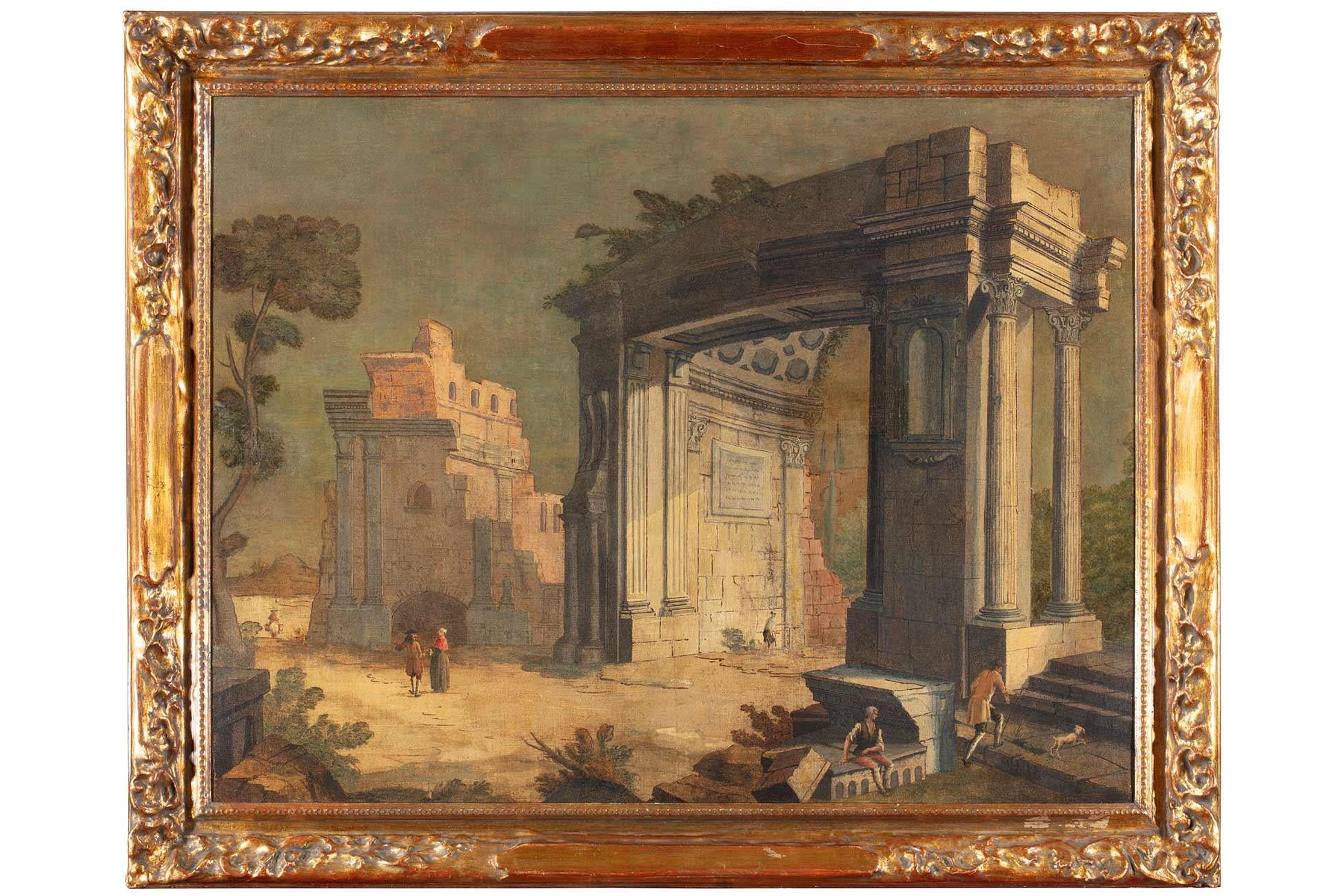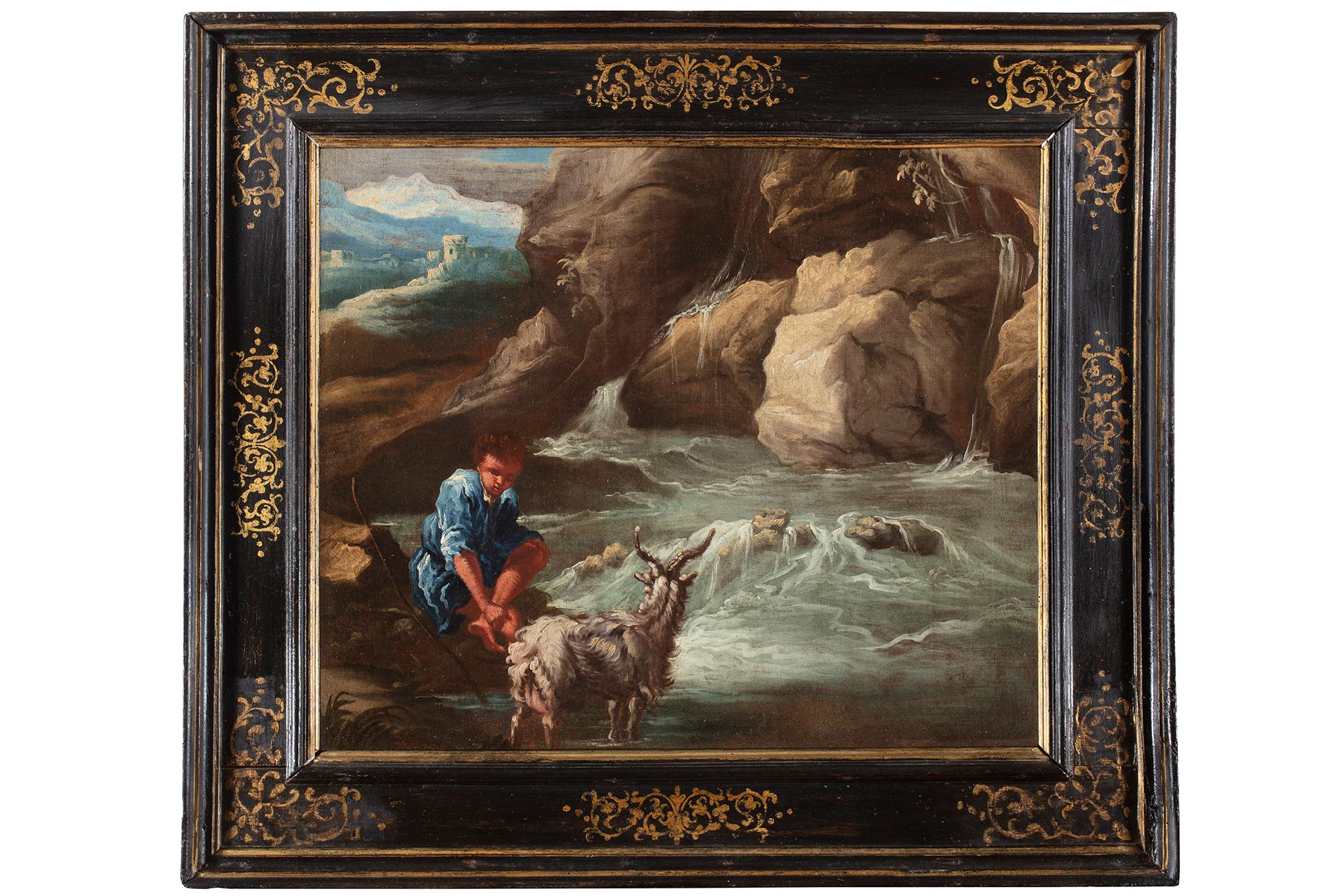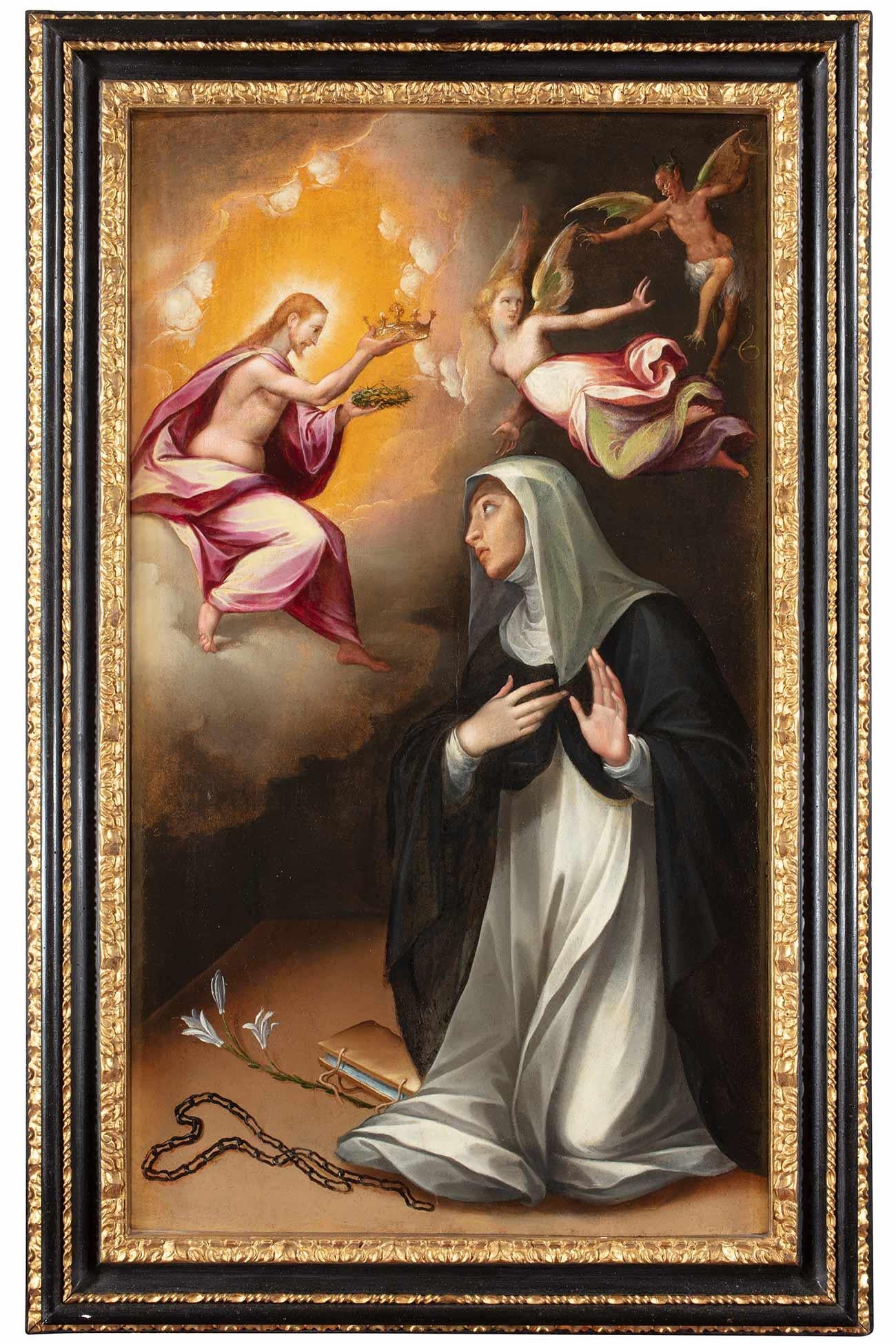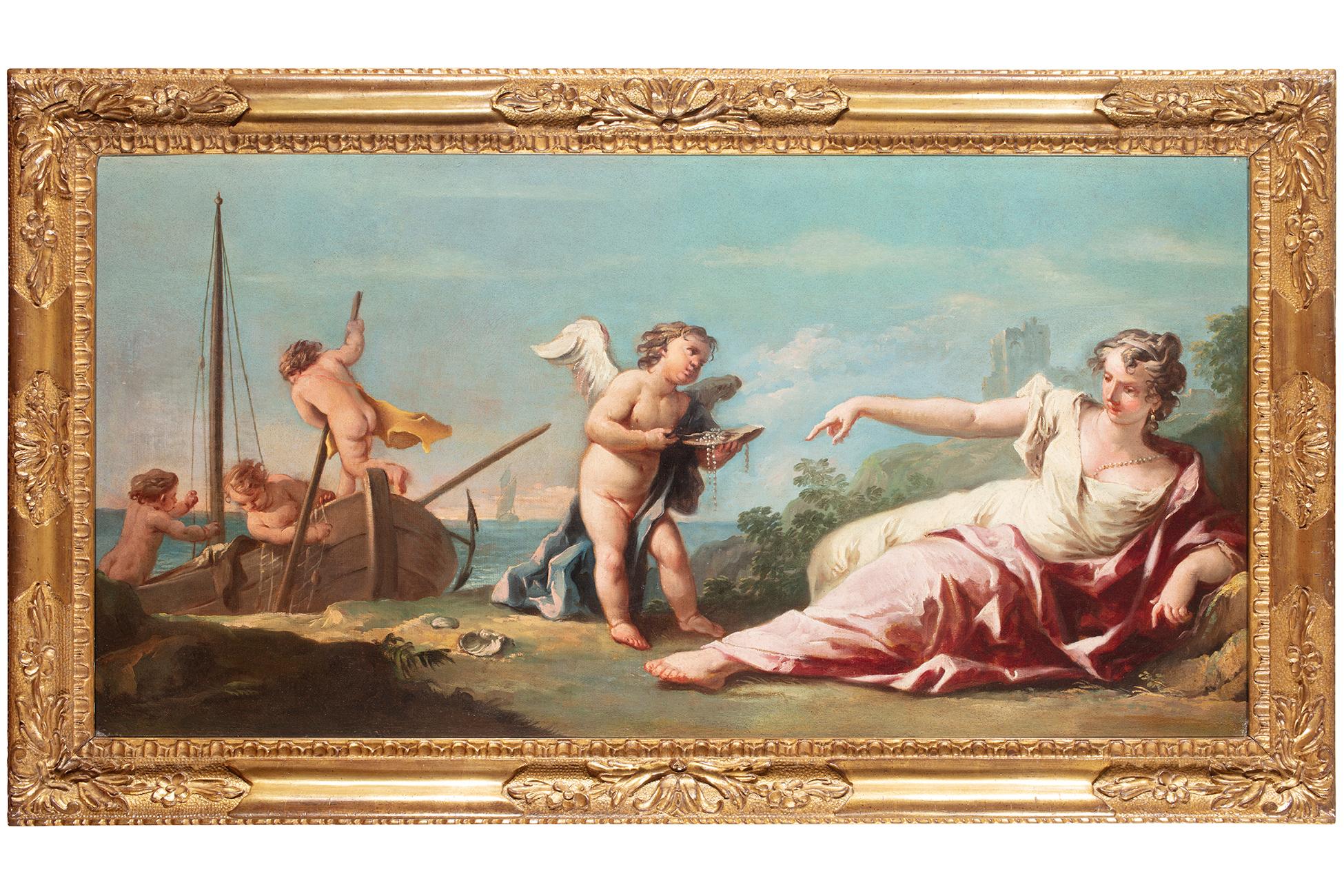Items Similar to Early oil depicting the Great Fire of London
Want more images or videos?
Request additional images or videos from the seller
1 of 7
Early oil depicting the Great Fire of LondonCirca 1690
Circa 1690
About the Item
The Great Fire of London in September 1666 was one of the greatest disasters in the city’s history. The City, with its wooden houses crowded together in narrow streets, was a natural fire risk, and predictions that London would burn down became a shocking reality. The fire began in a bakery in Pudding Lane, an area near the Thames teeming with warehouses and shops full of flammable materials, such as timber, oil, coal, pitch and turpentine. Inevitably the fire spread rapidly from this area into the City. Our painting depicts the impact of the fire on those who were caught in it and creates a very dramatic impression of what the fire was like. Closer inspection reveals a scene of chaos and panic with people running out of the gates. It shows Cripplegate in the north of the City, with St Giles without Cripplegate to its left, in flames (on the site of the present day Barbican). The painting probably represents the fire on the night of Tuesday 4 September, when four-fifths of the City was burning at once, including St Paul's Cathedral. Old St Paul’s can be seen to the right of the canvas, the medieval church with its thick stone walls, was considered a place of safety, but the building was covered in wooden scaffolding as it was in the midst of being restored by the then little known architect, Christopher Wren and caught fire. Our painting seems to depict a specific moment on the Tuesday night when the lead on St Paul’s caught fire and, as the diarist John Evelyn described: ‘the stones of Paul’s flew like grenades, the melting lead running down the streets in a stream and the very pavements glowing with the firey redness, so as no horse, nor man, was able to tread on them.’
Although the loss of life was minimal, some accounts record only sixteen perished, the magnitude of the property loss was shocking – some four hundred and thirty acres, about eighty per cent of the City proper was destroyed, including over thirteen thousand houses, eighty-nine churches, and fifty-two Guild Halls. Thousands were homeless and financially ruined. The Great Fire, and the subsequent fire of 1676, which destroyed over six hundred houses south of the Thames, changed the appearance of London forever. The one constructive outcome of the Great Fire was that the plague, which had devastated the population of London since 1665, diminished greatly, due to the mass death of the plague-carrying rats in the blaze.
The fire was widely reported in eyewitness accounts, newspapers, letters and diaries. Samuel Pepys recorded climbing the steeple of Barking Church from which he viewed the destroyed City: ‘the saddest sight of desolation that I ever saw.’ There was an official enquiry into the causes of the fire, petitions to the King and Lord Mayor to rebuild, new legislation and building Acts. Naturally, the fire became a dramatic and extremely popular subject for painters and engravers. A group of works relatively closely related to the present picture have been traditionally ascribed to Jan Griffier the elder, or being derived from Griffier’s work. This identification appears to be largely based on the existence an early nineteenth century lithograph after a painting (now unknown) of a similar subject which was at the time attributed to Griffier. Jan Griffier the elder (c.1652-1718) born in Amsterdam, who is recorded as being in London soon after the Great Fire of 1666. The present work appears to have been painted in the period 1690-1710 and it demonstrates the enduring appeal and interest in the subject matter. In its drama, multiple scenes of human interest and scale, this picture is one of the most remarkable depictions of the fire to appear on the market.
- Attributed to:Jan Griffier the Elder (1645 - 1718, Dutch)
- Creation Year:Circa 1690
- Dimensions:Height: 34.25 in (87 cm)Width: 49 in (124.46 cm)
- Medium:
- Movement & Style:
- Period:
- Condition:Preserved in good condition, house in an ebonised and giltwood frame.
- Gallery Location:London, GB
- Reference Number:1stDibs: LU150727721402
About the Seller
5.0
Recognized Seller
These prestigious sellers are industry leaders and represent the highest echelon for item quality and design.
1stDibs seller since 2021
- ShippingRetrieving quote...Ships From: London, United Kingdom
- Return PolicyA return for this item may be initiated within 14 days of delivery.
More From This SellerView All
- 18th century view of the Elephant and Castle in LondonLocated in London, GBCollections: With Martyn Gregory; Judy Egerton, 1984, acquired from the above; By descent to 2014. Exhibited: London, Martyn Gregory, Exhibition of English & Continental Watercolours, 1984, no. 94. London, Lowell Libson...Category
18th Century Old Masters Landscape Paintings
MaterialsGouache, Vellum
- 18th century allegorical painting of The Triumph of BeautyLocated in London, GBExhibited: London, Royal Academy, 1800, no. 93 What was happening in British history painting in around 1800? In recent discussions of the emergence of a British School of history painting following the foundation of the Royal Academy in 1768, this is a question which is rarely posed and one which is not easily answered. Examination of surviving Royal Academy exhibition catalogues reveals a profusion of artists’ names and titles, few of which remain immediately recognizable, whilst endeavours to explain the impact of exhibition culture on painting - such as the 2001 Courtauld show Art on the Line - have tended to focus on the first and second generation of Royal Academician, rather than young or aspiring artists in the early nineteenth century. This makes the discovery and identification of the work under discussion of exceptional importance in making sense of currents in English painting around 1800. Executed by Edward Dayes...Category
18th Century Old Masters Figurative Paintings
MaterialsCanvas, Oil
- 19th century portrait painted in St Petersburg in 1819Located in London, GBSigned, inscribed and dated, lower right: 'Geo Dawe RA St Petersburgh 1819', also signed with initials, lower centre: 'G D RA'; and signed and inscribed verso: 'Geo Dawe RA Pinxit 1819 St Petersburgh'; Also inscribed on the stretcher by Cornelius Varley with varnishing instructions. Collections: Private collection, UK, 2010 Literature: Galina Andreeva Geniuses of War, Weal and Beauty: George Dawe...Category
19th Century Old Masters Portrait Paintings
MaterialsCanvas, Oil
- 18th century portrait of the painter Nathaniel DanceLocated in London, GBCollections: Robert Gallon (1845-1925); Private Collection, UK. Oil on canvas laid down on panel Framed dimensions: 11.5 x 10 inches This highly engaging, previously unpublished portrait by Johan...Category
18th Century Old Masters Portrait Paintings
MaterialsCanvas, Oil, Wood Panel
- Regency portrait drawing of Arabella Graham-ClarkeBy John DownmanLocated in London, GBCollections: The sitter, and by descent; Christie's, 19th March 1928, lot 6; Private collection to 2019 Literature: G.C. Williamson, John Downman, A.R.A., his Life and Works, Lon...Category
Early 19th Century Old Masters Portrait Drawings and Watercolors
MaterialsWatercolor, Pencil
- Regency portrait drawing of Lady NugentBy John DownmanLocated in London, GBCollections: With Ellis Smith, London; Private collection, to 2015. Literature: G.C. Williamson, John Downman A.R.A., his Life and Works, p. lviii no's. 2 and 3, p. xxxi. Exhi...Category
19th Century Old Masters Portrait Drawings and Watercolors
MaterialsPencil, Watercolor
You May Also Like
- 18th Century By Vincenzo Re The Pool of Bethesda Oil on CanvasLocated in Milano, LombardiaExpertise by Prof. Giancarlo Sestieri. Vincenzo Re (Parma, 1695 – Napoli?, 1762) born in Parma, was an Italian scenic designer who during his career worked as initially an assistant...Category
18th Century Old Masters Landscape Paintings
MaterialsCanvas, Oil
- 17th Century by Simone Cantarini Adoration of The Magi Painting Oil on CanvasLocated in Milano, LombardiaSimone Cantarini (Pesaro 1612 - Verona 1648) Adoration of the Magi Oil on paper applied to canvas, cm. 16,5 x 24 – with frame cm. 22 x 29 Antique sh...Category
Early 17th Century Old Masters Figurative Paintings
MaterialsCanvas, Cotton Canvas, Oil
- 18th Century by Antonio Stom Architectural Capriccio Oil on Canvas_By Antonio StomLocated in Milano, LombardiaAntonio Stom (Venice c. 1688 - 1734) Architectural Capriccio oil on canvas, cm. 88 x 113 - with frame cm. 106 x 132 Carved, sculpted and gilded wooden frame Expertise: Giancarlo S...Category
Early 18th Century Old Masters Landscape Paintings
MaterialsCanvas, Cotton Canvas, Oil
- 18th Century by Giuseppe Pianca Shepherd with Goat and River Oil on CanvasLocated in Milano, LombardiaGiuseppe Antonio Pianca (Agnona di Borgosesia/VC, 1703 - after 1757) oil on canvas, cm. 49 x 57 - with frame cm. 67 x 77 Antique shaped wooden cassetta frame, ebony and gold decora...Category
18th Century Old Masters Landscape Paintings
MaterialsCanvas, Cotton Canvas, Oil
- 16th Century by Cristofano Roncalli Saint Catherine of Siena Oil on CanvasLocated in Milano, LombardiaCristofano Roncalli (Pomarance 1552 - Rome 1626) Saint Catherine of Siena chooses the crown of thorns oil on wood, cm. 101,5x59.5 - with frame cm. 120x76 Shaped, carved and sculpted wooden cassetta frame, partly gilded and partly ebonized wood Expertise: Marco Ciampolini The marvellous scene that opens before our eyes is that of Christ's apparition to Saint Catherine of Siena; she must choose between a golden crown, the symbol of earthly royalty, and a crown of thorns, the symbol of virtuous Christian sacrifice. Catherine does not hesitate to choose the crown of thorns, her life in imitation of...Category
16th Century Old Masters Landscape Paintings
MaterialsCanvas, Cotton Canvas, Oil
- 18th Century by Gaspare Diziani Venus With Cupid Oil on CanvasBy Gaspare DizianiLocated in Milano, LombardiaGaspare Diziani (Belluno, 1689 - Venice, 17 August 1767) Gilded, carved and sculpted wooden cassetta frame Expertise: Ugo Ruggeri The narration of our...Category
Early 18th Century Old Masters Landscape Paintings
MaterialsCanvas, Cotton Canvas, Oil





